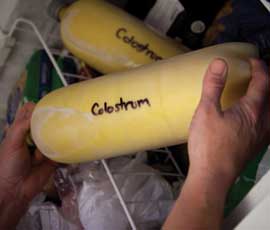Ask the Vet: Your queries on colostrum, ringworm

Three vets from Westpoint Vet Group answer your questions on colostrum, ringworm and fly strike
What can I use for emergency colostrum for a calf?
Ginney Sherwin from the Warnham practice: Colostrum is a source of energy and nutrients as well as supplying the calf with the key antibodies to help defend them against infections in the first weeks of life. The calf should ideally have 3 litres of good quality colostrum within the first six hours of life.
There are two options to look at in terms of replacement of colostrum. The first is using frozen colostrum from other cows. The colostrum should be frozen at minus 20C, usually in 2-litre doses. Thawing of the colostrum should be done slowly in warm water at 50C to avoid destroying the antibodies. The colostrum chosen for storage should be tested with a colostrometer to check that it is of high quality and should come from a cow of known disease status.
The other option is to use artificial colostrum. There are two different types of artificial colostrum; colostrum supplements and colostrum replacers. Colostrum supplements are not designed to completely replace colostrum, as they have <75g of immunoglobulins per litre. Colostrum replacers however are designed to replace natural colostrum and have a higher level of immunoglobulins (>75g/l). It is worth remembering that a calf needs a minimum 150g/l of immunoglobulins in the first 24 hours so more than one dose of the colostrum replacer maybe required.
What is the best treatment for calves with ringworm?
Tim Potter from the Warnham practice: Ringworm is a fungal skin disease occurring in most mammals including cattle and man. Control of ringworm is important as it causes not only production losses (damage to hides, reductions in growth rates), but can also be transmitted to people working with infected cattle.
As the environment is the major source of infection, with the fungal spores surviving there for many months, effective control of ringworm will only occur if the environment is properly cleaned and disinfected between batches of animals.
Ringworm will eventually cure itself but this may take as long as nine months. Affected animals can be treated with topical anti-fungal preparations. When using any topical treatments it is important that they are applied to all affected areas and that the crusts are removed to ensure the treatment reaches the affected hair follicles. As these topical treatments require repeated thorough applications, it may only be suitable for the management of a small number of animals.
There is a licensed vaccine for the prevention of ringworm in cattle and this is very effective in the prevention of the disease. The vaccine can also be used in animals already affected by ringworm to help speed up the resolution of the lesions.
We have a problem with ewes and ram lambs headbutting between themselves leading to head wounds which are slow to heal and as a result get covered in flies. We have tried a lot of fly creams and sheep fly sprays which seem to remove the flies, but a day later they are back again and the warm humid weather isn’t helping. Is there anything we could use that would be more effective over a longer term?
Peter Aitken from the Three Counties practice: Unfortunately, rams and ewes will not always see eye to eye so disagreements between them are not uncommon, usually resulting in a meeting of the heads which can on occasions cause damage to the skin and tissues over the poll and forehead area. This damage is an invitation to flies to come and pay them a visit which can set up some rather nasty areas of fly strike.
There are various creams and potions available to treat this sort of situation, but the best control is by thorough cleaning and disinfection of the affected areas, including removing any wool from around the edges of the damaged skin.
All visible maggots should be removed. Once clean, the area can then be treated with an appropriate pour on/spot on product licenced for use in sheep for the treatment of strike.
Note that not all products used for fly treatment claim to treat active strike; some products are designed for prevention only, not treatment.
If in doubt about which products to use you should consult your vet or suitably qualified person who can advise you appropriately.
Join our forum discussions on these and other health topics
